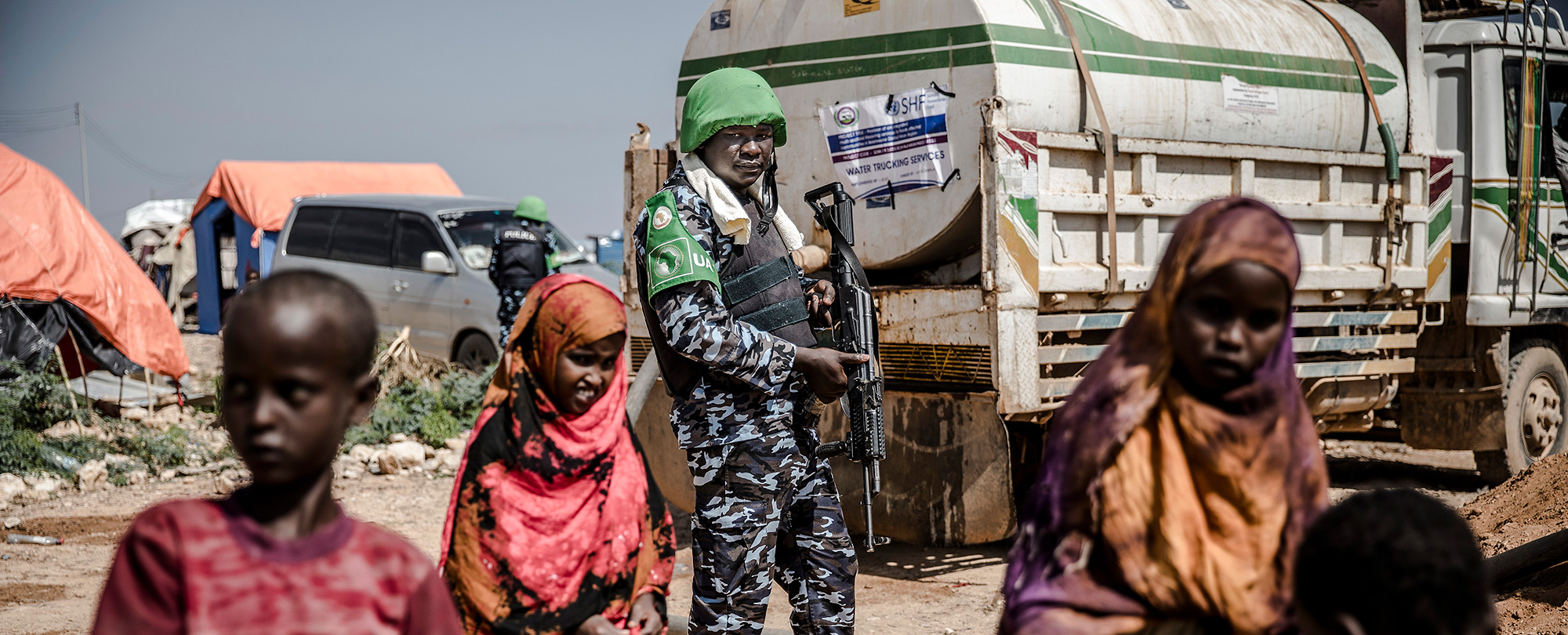The 20th anniversary of the founding of the African Union in 2022 was a watershed year for African-led peace operations. In response to a variety of conflicts and crises, the African Union (AU) and the Regional Economic Communities (RECs) authorized four new African-led peace operations, matching 2017 for the most in any calendar year. The AU and regional actors now oversee 10 peace operations, comprising more than 70,000 authorized personnel, spread across 17 African countries.
These operations are critical tools for managing conflict. Over the past 20 years, African-led peace operations have undertaken innovative missions to address unconventional threats. They have improved cooperation between regional security forces. At times, they have also provided normative leadership in responding to atrocities and unconstitutional seizures of power. Despite these contributions, African-led peace operations possess limited operational capabilities, are poorly integrated with civilian-led conflict management efforts, and have failed to intervene decisively in the continent’s most significant armed conflicts.
For the AU to step into its long hoped-for role as the primary guarantor of peace and security in Africa, the AU and member states will need to institutionalize achievements and address shortcomings in the current regional security architecture.
Key Features and Trends of African-Led Peace Operations
Since the turn of the millennium, 38 African-led peace operations have been authorized, deploying to 25 countries. By far, the AU has been the most active supporter of these operations, authorizing 22 total missions. The Economic Community of West African States (ECOWAS) has authorized 6, followed by the Organization of African Unity (OAU) (4), the Economic Community of Central African States (ECCAS) (2), the Southern Africa Development Community (SADC) (2), and the member states of the Accra Initiative, Community of Sahel-Saharan States (CEN-SAD), and East African Community (EAC) (1).
Growth in African-Led Peace Operations (2000-2023)
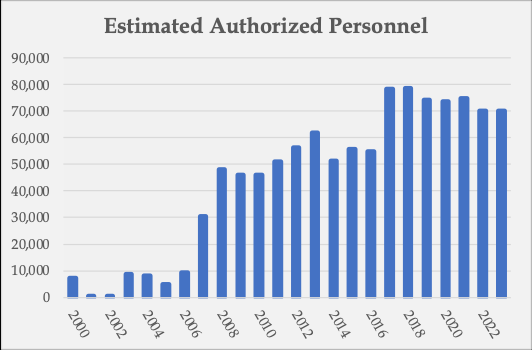

There is no such thing as a cookie-cutter African-led peace operation. They have ranged in size from less than a dozen personnel, as with the African Union Technical Support Team to The Gambia (AUTSTG), to over 20,000, as was the case with the African Union Mission to Somalia (AMISOM) and the African Union – United Nations Hybrid Mission in Darfur (UNAMID). The operations of the latter two, multidimensional peace enforcement missions, have lasted nearly two decades, making them the longest running African-led peace operations. Others, like the ECOWAS Mission in Liberia (ECOMIL), the ECOWAS Mission in Côte d’Ivoire (ECOMICI), the African Union Observer Mission in the Comoros (MIOC), the African Union Mission for Support to the Elections in the Comoros (AMISEC), and Operation Restore Democracy have occurred over the span of less than a calendar year.
African-led peace operations have implemented a wide array of mandates:
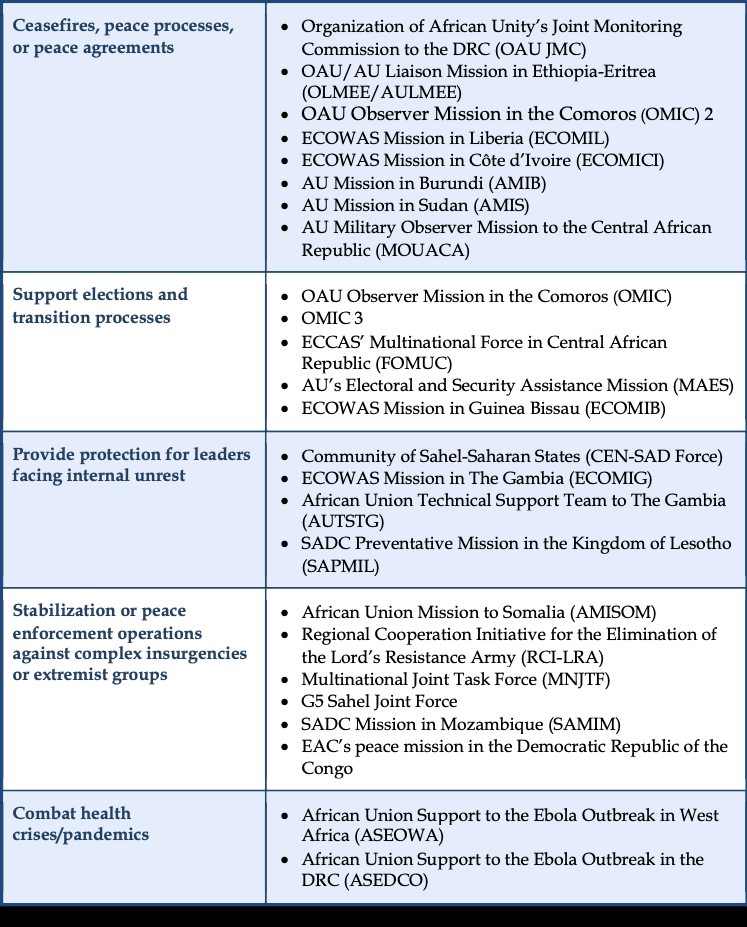
The rise and persistence of African-led peace operations represent a trend toward localized ownership over conflict management. Due to a divided United Nations (UN) Security Council and what has been perceived to be the limited success of large, multidimensional, UN-sponsored missions, the deployment of UN forces in Africa has waned. No new UN mission has been authorized in Africa in close to a decade. With the drawdown of MINUSMA, the UN mission in Mali, the UN will only have five remaining active missions on the continent. Meanwhile, the AU, RECs, and regional actors have authorized 16 new peace operations over the past decade, 10 of which are active.
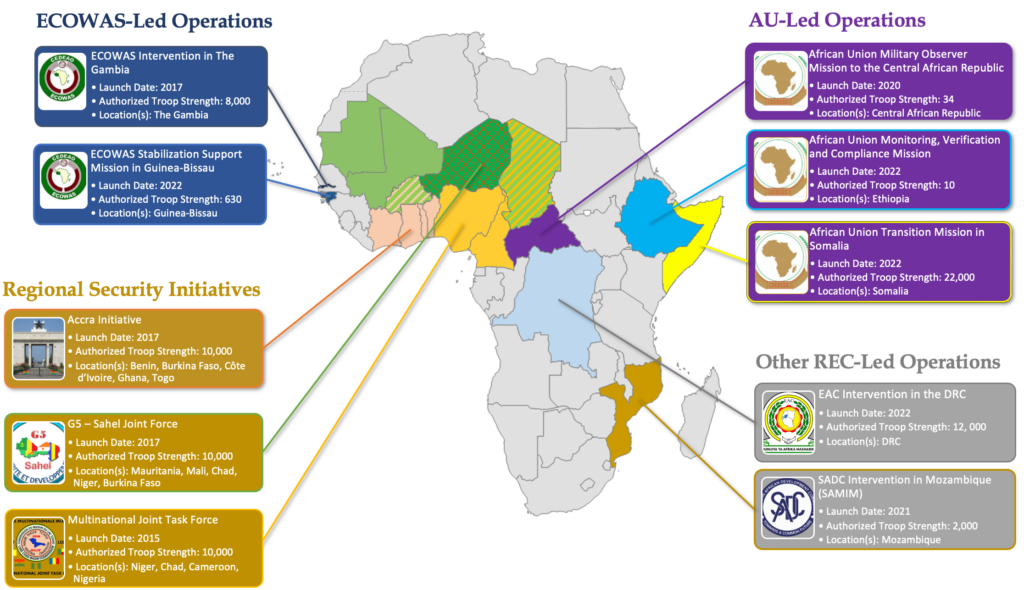
Even within the context of African-led peace operations, a devolution toward more local ownership is apparent. Of the 10 ongoing peace operations currently active in Africa, only 3—the African Union Transition Mission in Somalia (ATMIS), the African Union Military Observer Mission to the Central African Republic (MOUACA), and the tiny African Union Monitoring, Verification and Compliance Mission (AU-MVCM) in Tigray region, Ethiopia—are AU-mandated, meaning they have been authorized, organized, and logistically supported principally by the African Union. The rest have been led by RECs (such as ECOWAS, the EAC, or SADC) or regional organizations (like the G5 Sahel and the Lake Chad Basin Commission) with varying degrees of support from the AU.
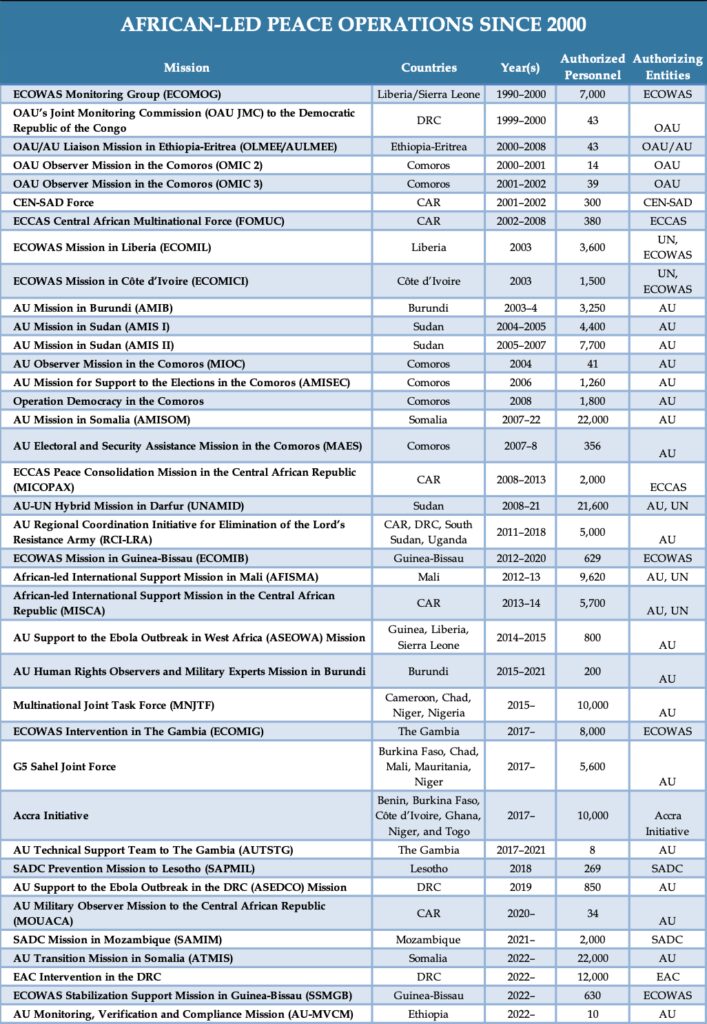
African-Led Peace Operations: Successes
African-led peace operations are growing in part because they have found a measure of success in addressing Africa’s armed conflicts. They illustrate the distinctive role regional actors can play in addressing shared security challenges.
First, regional actors can deploy to conflict zones more rapidly and with less cost than international peacekeepers. This was the case with one of the first major African-led interventions of the 2000s, the ECOWAS Mission in Liberia (ECOMIL). It was deployed to Liberia on September 9, 2003, 3 weeks after the signing of a comprehensive peace agreement, before being converted into a UN mission 1 month later. Other African-led peace operations that have been deployed as rapid response operations to prepare in whole or in part for a larger UN mission include: CEN-SAD, AMIS I and II, the African-led International Support Mission in Mali (AFISMA), and the African-led International Support Mission in the Central African Republic (MISCA).
Second, African-led peace operations have shown more doctrinal flexibility than UN-sponsored peacekeeping missions, which rarely deploy in the absence of a peace process or agreement. Six of the 17 African-led peace operations of the past decade have been mandated to fight militant Islamist groups in the Sahel, Somalia, the Lake Chad Basin, the Democratic Republic of the Congo, and Mozambique. Because these groups disavow political settlements, the UN has refrained from sponsoring peace operations with explicit mandates to confront them. Nevertheless, the threat from Islamist militant violence, fatalities from which have doubled since 2019, remains perhaps the most significant threat to peace and stability in the eyes of many AU member states.
Third, African-led peace operations have helped African security forces significantly improve coordination with one another in addressing cross-border security challenges, another area that has been neglected by state-centric UN peacekeeping doctrine. This has been especially evident in what are known as the AU-authorized regional missions or ad-hoc security initiatives (ASIs), which have included AU’s RCI effort to counter the LRA, the Lake Chad Basin’s Multinational Joint Task Force, and the G5 Sahel Joint Force. In each case, under the auspices of a peace operation, regional militaries seeking to address a cross-border insurgency:
Established a joint headquarters.
Stood up mechanisms to share intelligence.
Undertook joint cross-border operations.
Implemented “hot pursuit” rules that enabled security forces to pursue insurgent groups across borders.Particularly in the cases of the MNJTF and the RCI-LRA, ASIs have succeeded in restricting and, in the case of the RCI-LRA, virtually eliminating the threat from these insurgencies. Given that a classic tactic of insurgent groups is to exploit borders and border regions to evade state forces, this is a significant contribution.
African-led peace operations have upheld AU norms by intervening to prevent crises stemming from unconstitutional seizures of power.Finally, at the request of legitimately elected leaders in smaller states, African-led peace operations have upheld AU norms by intervening to prevent crises stemming from unconstitutional seizures of power. In Comoros, in 2008, it acted through Operation Restore Democracy to remove a renegade military government in Anjouan, the first ever AU-sponsored operation to topple a recalcitrant leader. In 2017, the threat of military force by ECOMIG led Yahya Jammeh to step down in favor of his democratically elected successor, Adama Barrow. In both Lesotho (SAPMIL) and Guinea-Bissau (ECOMIB), Regional Economic Communities intervened to shore up shaky leaders in the aftermath of assassinations or coup attempts by their militaries.
Indeed, the decline of coups and conflicts across Africa in the early 2000s are partly indebted to regional bodies being willing to uphold these norms. The recent rise is in no small part because leaders in many African countries have lacked the political will to fully commit to upholding them.
There exists legitimate concern among researchers over whether peacekeeping can be effective in the absence of political settlements or peace agreements. Nevertheless, the AU’s willingness to challenge international peacekeeping doctrine has enabled regional actors to adapt to 21st century armed conflict in ways the UN has not. Through rapid response capabilities, doctrinal innovation, improved regional coordination, and by acting to uphold continent-wide non-indifference norms, African-led peace operations are supplanting international ones.
African-Led Peace Operations: Challenges
Though African-led operations have shown great promise in addressing Africa’s security challenges, they are not without shortcomings.
Regionally led peace operations possess limited operational and expeditionary capabilities. The largest African-led peace operations have been almost entirely dependent on external donors such as the European Union, the United States, and the United Nations, which collectively spend billions of dollars a year on multilateral peace operations. Through the operationalization of the African Standby Forces and a Peace Fund supported by a 0.2-percent levy on imports, the African Union has long cultivated capabilities of its own.
These efforts have been only partially successful. The Standby Forces have progressed but are not yet fully operational. The Peace Fund has so far raised around $250 million, short of its $400 million goal, which itself is barely enough to fund even a modest-sized expeditionary deployment for 1 year.
Peace operations need to be better aligned with civilian- and locally led efforts to manage conflict.In addition, the military components of African-led peace operations need to be better aligned with civilian- and locally led efforts to manage conflict. Most African-led peace operations have focused on the deployment of military force, with limited coherence or integration with civilian ministries, development agencies, or locally driven conflict prevention and mitigation efforts. At times, African peacekeepers have displayed a lack of professionalism that has implicated them in corruption scandals, sexual abuse, and extrajudicial killings of civilians.
In an age of complex insurgencies that take advantage of local grievances and are adept at exploiting heavy-handed state responses, these shortcomings are particularly problematic. Some African-led peace operations, such as the MNJTF, have achieved impact over time by improving coordination with external donors, local leaders, and regional entities (such as the Lake Chad Basin Commission) to facilitate humanitarian assistance, the return of refugees, and stabilization programs. Others, such as the G5 Sahel Joint Force, have been focused mainly on countering violent extremism and have been less integrated with stabilization efforts led by the Sahel Alliance, the UN, bilateral partners, and dozens of NGOs. This remains a major shortcoming of attempts by various regional actors to stabilize the Sahel.
Finally, the African-led peace operations often fail to uphold the AU founding principle of non-indifference to leaders who, through war crimes, genocides, or unconstitutional seizures of power, abuse their citizens.
A high-water mark of frustration for many came in 2015, when the African Union Peace and Security Council failed to endorse a regional intervention in the context of a crisis precipitated by Burundian President Pierre Nkurunziza’s decision to seek a third term in office. Similarly, the absence of any major African-led peace operation to address massive conflicts in Ethiopia and Sudan illustrates the hard reality of the AU’s limited intervention capabilities. After failing to take decisive action against coups in Mali (2020 and 2021) and Burkina Faso (both in 2022), ECOWAS’s threatened intervention into Niger in response to the presidential guard’s seizure of power will provide a critical test of how willing—and capable—regional leaders are to curb the wave of coups and coup attempts that have affected West Africa.
Takeaways
African-led peace operations are growing ever-more crucial to addressing the continent’s security challenges. It is no stretch to argue that future peace and security on the continent depends upon the continued growth and evolution of African-owned modalities of conflict prevention and resolution. To achieve their full potential, the AU, RECs, and member states must reinforce the successes and address the shortcomings of African-led peace operations.
The AU and RECs should adopt a standard, institutionalized playbook for responding to shared cross-border security challenges. The AU, working in close coordination with the RECs, could provide more formal strategic guidance and operationalize the coordination mechanisms that have been developed through the regional security initiatives and integrate them into the existing African Standby Forces. This could include support to ongoing efforts to build confidence across regional security forces, establishing fusion centers to share intelligence, and mechanisms to command, conduct, and operationalize joint operations targeting specific groups. AU-led efforts could be particularly useful in cases where the threats span RECs.
Second, the AU and RECs need to do a better job of adopting integrated, holistic approaches to conflict management. This will require increased efforts to train African troops who serve in African-led peace operations on critical issues such as civilian harm mitigation, respect for the laws of armed conflict, and human rights. It will also require ensuring that the military components of African-led peace operations are integrated into efforts by civilian agencies, local leaders, humanitarian actors, and the international community to address the underlying causes of conflict through development assistance, humanitarian relief, and locally led peace initiatives. Here, the RECs and ad-hoc security initiatives could afford to do a better job of cooperating with the AU, which has established guidelines on civilian protection and harm mitigation.
Finally, African-led peace operations require more resources and sustainable financing mechanisms if they ever are to obtain the muscle they truly need to grapple with Africa’s most significant security threats. Over the long term, this will require greater commitment from African states themselves to ensure that the AU meets its funding targets. In the near term, however, enabling the UN to use its peacekeeping funds to support African-led peace operations could provide the global peacekeeping enterprise with a much-needed shot in the arm.
African-led peace operations have demonstrated they can be relevant and adaptable to many of Africa’s security challenges. Continued innovation in African led peace operations will be crucial to improving their effectiveness in addressing Africa’s most complex armed conflicts.
Additional Resources
Andrew E. Yaw Tchie, “African-Led Peace Support Operations in a Declining Period of New UN Peacekeeping Operations,” Global Governance 29 (2023).
Claudia Pfiefer Cruz, “Multilateral Peace Operations in 2022: Developments and Trends,” Backgrounder, SIPRI, May 29, 2023.
Security Council Report, “The Financing of AU Peace Support Operations: Prospects for Progress in the Security Council,” Research Report, April 2023.
Cedric de Koning and Andrew E. Yaw Tchie, Natasja Rupesinghe, and Anab Ovie Grand, “Adapting the African Standby force to Africa’s Evolving Security Landscape,” ACCORD, March 30, 2023.
Paul Nantulya, “The African Union at 20: Much Accomplished, More Challenges Ahead,” Spotlight, Africa Center for Strategic Studies, February 22, 2022.
Africa Center for Strategic Studies, ”Taking Stock of African Peace Operations: An Overview,” Webinar, February 2021.
Paul D. Williams “Learning Lessons from Peace Operations in Africa,” in Terence McNamee, and Monde Muyangwa, eds., The State of Peacebuilding in Africa (London: Palgrave Macmillan, 2021).
Africa Center for Strategic Studies, “Resolving Africa’s Conflicts: Toward an African Model of Peace Operations,” Video, June 2016.
Paul D. Williams, “Peace Operations in Africa: Lessons Learned since 2000,” Africa Security Brief No. 25, Africa Center for Strategic Studies, July 2013.
